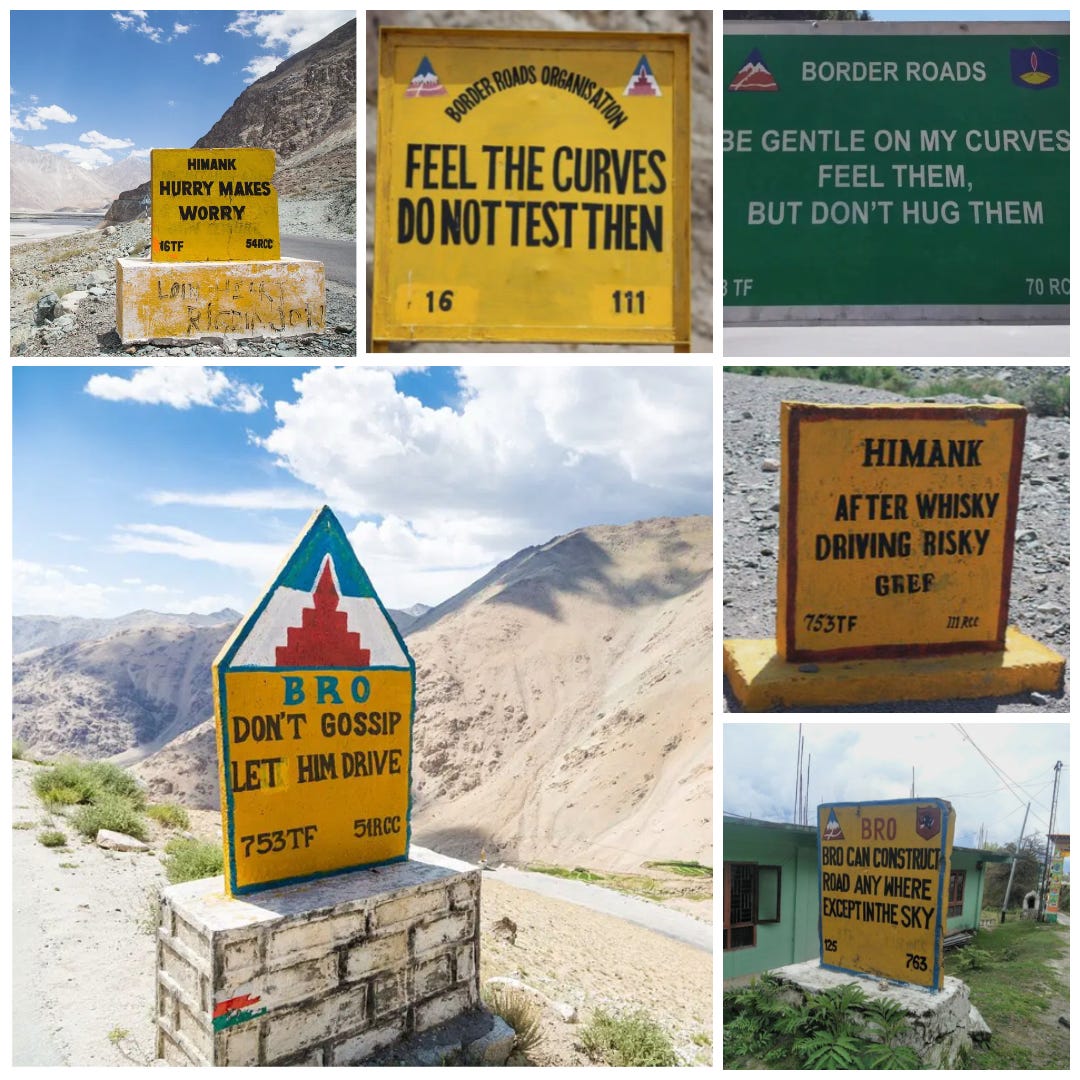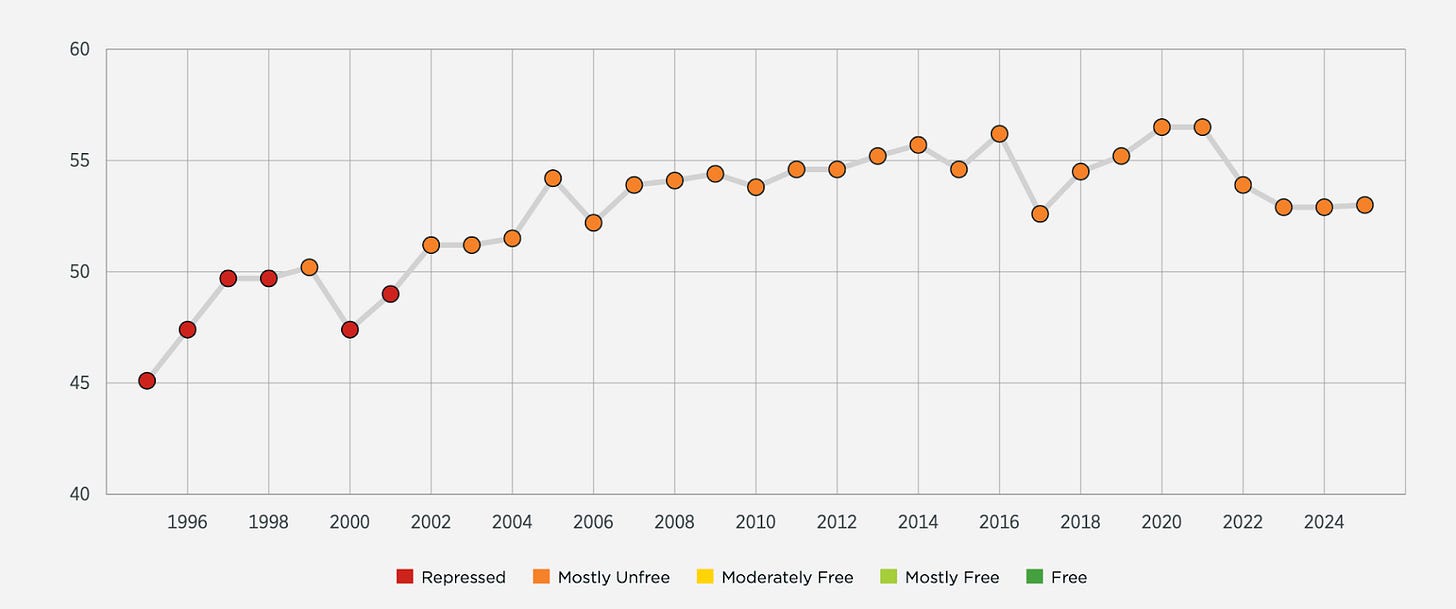The Underutilised Policy Instrument called ‘Nudge’
Understanding the policy instrument of nudge and its potential uses for India
I have had the opportunity to take road trips through some of the border states of India. Border roads present you with a lot of challenges. But road quality is not one of them. The Border Roads Organisation (BRO), under the Ministry of Defence, has constructed some of the best roads in these difficult terrains. But with good quality roads comes the temptation to drive fast. But as anyone who has been through some of the BRO constructed roads knows, riding fast through these roads is easier said than done. Not because it is difficult to speed, or because fines are imposed. It is because BRO has put deliberate efforts to inform the drivers about the cons of speeding. There is a roadside sign that nudges drivers to slow down every few meters. These signs are creative, emotional, funny and hence hard to miss. It has an effect on you. It keeps you in check. It makes you giggle. It makes you want to comply.
While data on road accidents in border roads are not separately available, research shows the benefits of such non-intrusive yet persuasive instruments. These instruments are generally called Nudges. In this article, we discuss what nudges are, their uses, and how they are a useful policy instrument for the Indian context.
Enchantment of the State
The Indian state has traditionally followed a strong state-centric model of development. Termed as ‘Nehruvian Consensus’, this development paradigm focussed on expert-led centralized economic planning. It tried to achieve swift development for the country, at par with western democracies. For this purpose, the economy was strictly regulated, entry and exit of firms was controlled by the state, public sector dominated investments in education, health, infrastructure etc. But not only did this model of development not deliver on its promises of swift development, it resulted in restricting people’s economic, political and social freedoms.
Over the years India has changed course, away from this model of development. With the 1991 reforms, markets were given more freedoms and state control over the economy was eased. While this has led to swifter rates of development and poverty eradication, India still ranks very low among the world nations in economic freedoms.
Index of Economic Freedom - India (1996 - 2024)
(Source: The Heritage Foundation)
But why does even after liberalising the economy and encouraging the markets to lead the way in economic development, the Indian state’s stranglehold on the economy still continues? While it is true that governments rarely relinquish their powers voluntarily, the government control of the economy is also because of the political expectations from the citizens. Ruling parties across the spectrum in India, are expected to control prices, heavily invest in development etc. even if it means high taxation or curtailing freedoms. Political scientist Sudipta Kaviraj calls this Indian people’s ‘enchantment of the state’. According to him the Indian voters have a romanticized vision of the state which leads to inflated expectations, particularly in the realms of economic planning, social justice, and nation-building. The average Indian voter distrusts the markets and expects the government to guide the economy into development.
In this context, how can the Indian state leverage the benefits of freeing the economy from its control, while meeting the political expectations of its people? The policy instrument of Nudge might offer a solution.
Why Nudge?
Nudge is a behavioural economics idea that leverages insights from human psychology to influence the choices of people. Nudge, as the word indicates, is about gently steering people towards desirable behaviour. It allows the state to influence people and their choices, while not curtailing their freedoms in any significant way. Richard Thaler and Cass Sunstein who first proposed this idea, defines Nudge like this:
“A nudge is any aspect of the choice architecture that alters people’s behavior in a predictable way without forbidding any options or significantly changing their economic incentives.”
Choice architecture refers to how choices are presented to the people. Nudge is about making subtle changes in choice-presentation, in non-intrusive ways, to enable people to make choices that will benefit them in the long term. Altering the arrangement of items in a food menu to make people pick healthy options is an example of Nudge. Note that people still can pick unhealthy options. But with the new arrangement, they are more likely to pick health options.
Refer the table below to see how Nudge and the other alternatives apply in the case of road-signs:
One successful example where Nudge was utilised in India was in the Pradhan Mantri Jan Dhan Yojana (PMJDY). As part of PMJDY, direct benefit transfers were made part of several schemes. Beneficiaries were automatically enrolled (Nudge) in zero-balance bank accounts when signing up for other welfare schemes that included the direct benefit transfer provision.
Those who didn’t want such an account were allowed to opt-out without any penalties. Because of the default option of opening zero-balance accounts, most beneficiaries did not opt out of it. This resulted in the successful opening of crores of zero-balance accounts, something that wouldn’t have happened if people were given the choice to open an account without a default option already selected for them.
Leveraging the Potential of Nudge
Nudge offers tremendous potential in the Indian context. It gives the state an exit option to ease regulations without withdrawing completely from its choice-influencing role. Two examples where nudge can be used are given below:
Improving road safety
Currently, road safety is ensured using speed-limit cameras, fines, and mostly through police personnel conducting roadside checks. All these measures have significant costs associated with it. Moreover, they do not fundamentally alter the behaviour of the driver, who can still drive unsafely when there are no cameras, or police personnel.
One of the ways in which Nudge can be used to improve road safety is by making road safety requirements the default option in vehicles. For example, currently the seat belt mechanism works in such a way that, a driver by default is driving without seat belts. If changes in a car’s functionality can make wearing a seat belt default, effortless and automatic, people choosing to remove them might decrease. Similarly, building in features like default speed limits on cars, which has to be switched to a no-limit option, can cause drivers from over-speeding.
Improving the policy-making process
Sufficient research in economics indicates that price control by the government is harmful to the economy. Yet, successive governments succumb to political pressures and meddle with prices.
One of the ways in which this can be changed is to bring in a law, where all governments by default have to give their economic rationale on why price control in a particular instance is useful (and not harmful) to the economy. The government can choose not to give this explanation, but it has to be explicitly said so. Such a nudge on the government can demotivate the government from meddling with prices, or at least give the voters a reason on why they are doing so. Governments who opt out from giving such explanations, can be legally allowed to do so, but the political pressures of this option will make them think-twice before opting out.
Conclusion
Nudging happens all around us. Parents nudge their kids. Supermarkets nudge their customers to choose particular products. But it is not a policy instrument that is sufficiently used in India. The Indian state that struggles to ease its control on the economy and society, due to pressures and expectations from its voters can effectively use nudge techniques. This allows the government to influence people’s choices and while at the same time meet political expectations to some degree. All this could be done without disrupting the economy like regulations or controls might.







